| |
A Virtual Walk Through Jacksonville History
Stop 23: J. A. Brunner Building
Our next stop, the J.A. Brunner Building, is quite literally joined at the hip with its neighbor, the Orth Building. In fact, the ground floors share a wall, and the south wall of the second story of the Orth building rests on the north wall of the Brunner Building. The 1855 Brunner Building was the second brick building constructed in pioneer Jacksonville. It is the oldest surviving brick building in the town as well as the oldest in Oregon.
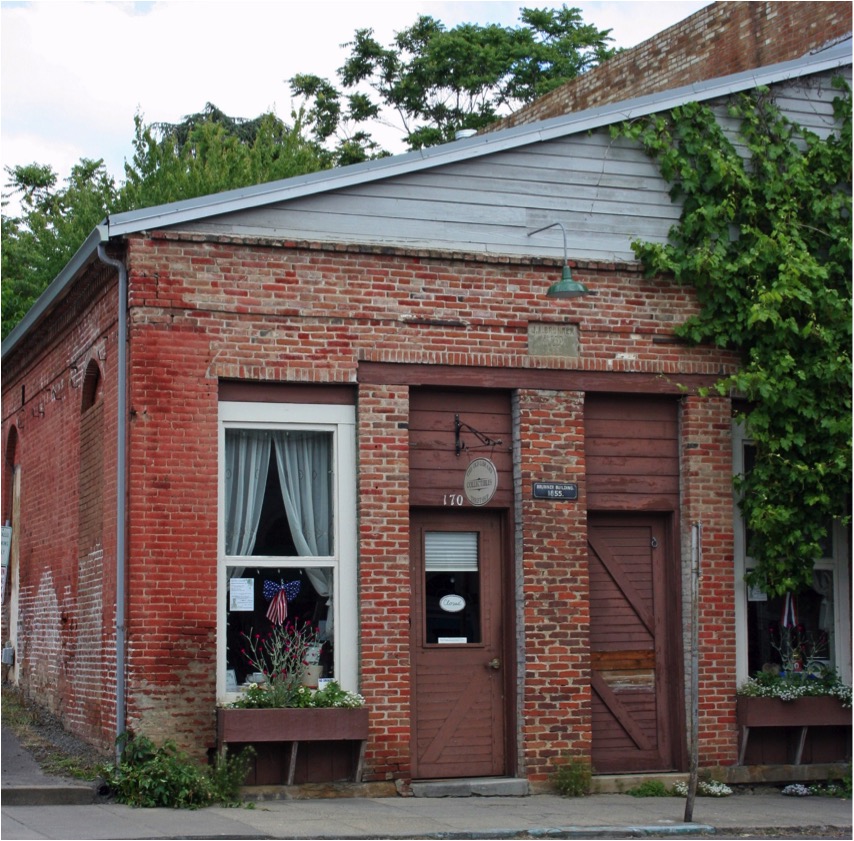 Photo courtesy of Carolyn Kingsnorth. Photo courtesy of Carolyn Kingsnorth.
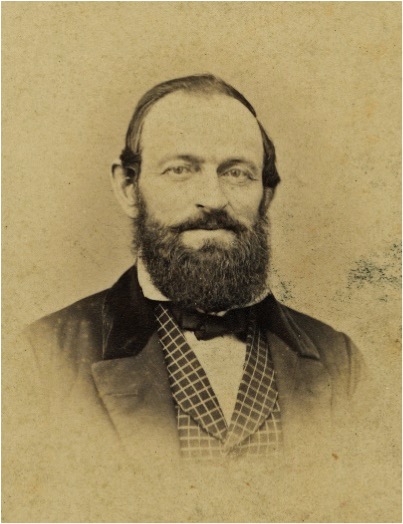 Jacob A. Brunner Jacob A. Brunner
SOHS #22296
|
A 31-year-old Jacob Brunner was one of the earliest Jewish merchants to arrive in Jacksonville. His name is recorded in the 1852 census along with that of his 20-year-old brother Herman. By 1853, Jacob and a partner, Henry Goldsmith, had purchased a parcel of land, including this lot, from James Clugage, the original donation land claim owner of most of the early town site. A map from that period shows Brunner’s name as the only one on the block. It was a prime location—Jacksonville’s earliest commercial intersection, the corner of West Main and South Oregon streets. Brunner and Goldsmith must have initially operated out of a wooden structure since by 1854 Brunner was reported to be carrying one of the mining camp’s heaviest stock of goods. |
In September 1854, brick manufacturers Horace and Abel In September 1854, brick manufacturers Horace and Abel Reed sold J.A. Brunner and Co. 60,000 “good bricks suitable for building,” to be delivered between April 15 and June 1, 1855. The cost was $14 per thousand with Brunner agreeing to provide up to half the total value in groceries and money as the work progressed. In return he secured a lien on the brickyard. The resulting building was originally a one-story unpainted brick block constructed in a simplified version of the commercial Italianate style. The structure has received numerous alterations over the years. The original façade had three bays, each with square headed doorways spanned by lintels and surmounted by arches. The south windows had iron shutters. The roof was sod, the only such roof in town. On the back was a shed-roofed frame addition. By January 1856, J.A. Brunner & Brother were advertising their “fire proof brick” store at the corner of Main and Oregon streets boasting “the largest and best assorted stock of goods … selected particularly to meet the wants of the farmers, mechanics, and miners of this country.”
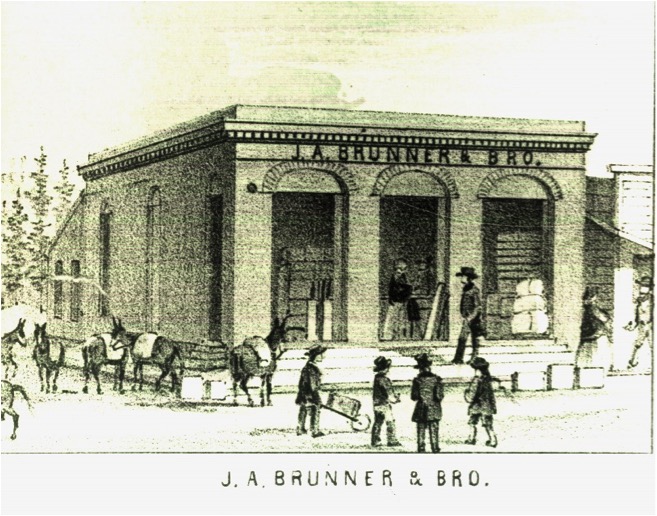 Photo Source: SOHS #00677 Photo Source: SOHS #00677
Stories abound that Brunner’s “fire proof brick” building with its iron shutters and sod roof were where women and children took shelter when Indians attacked Jacksonville during the final Rogue River Indian Wars of 1855-56. With the influx of miners, settlers, and merchants to Southern Oregon, conflict between Whites and Native Americans was inevitable, but there is no record of Jacksonville ever being attacked.
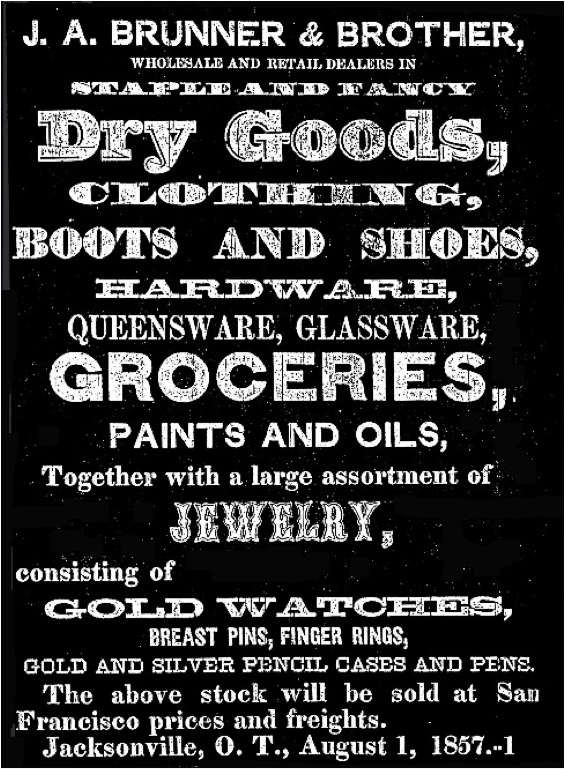 Table Rock Sentinel, August 1, 1857 Table Rock Sentinel, August 1, 1857 |
If anything, Jacksonville prospered during this period. An 1857 J.A. Brunner & Brother advertisement announced “staple and fancy dry goods, clothing, boots and shoes, hardware, Queensware, glassware, groceries, paints and oils, together with a large assortment of jewelry, consisting of gold watches, breast pins, finger rings, gold and silver pencil cases and pens” to be sold at San Francisco prices plus freight.
1860 appears to have been a banner year for Brunner. He became one of Jacksonville’s first elected trustees after the town government was formally organized. In April of that year, he bought out Goldsmith’s interest in the Jacksonville property. He then added a brick extension to the rear of the building along Main Street, reportedly making it the “largest store building in Jackson County” and “the largest south of Salem.” And in December 1860, Brunner sold John Drake the north end of his lot along with the right to attach a brick building to the north wall of his store. This right later passed with the deed to John Orth allowing Orth to construct his abutting commercial building in 1872. However, that same year shows Brunner moving back to San Francisco!
Without Brunner’s oversight, the success of the Jacksonville business waned and in 1862 it ceased operating. Goldsmith purchased the building back for cents on the dollar. For the next 30 years it was occupied by various merchants.
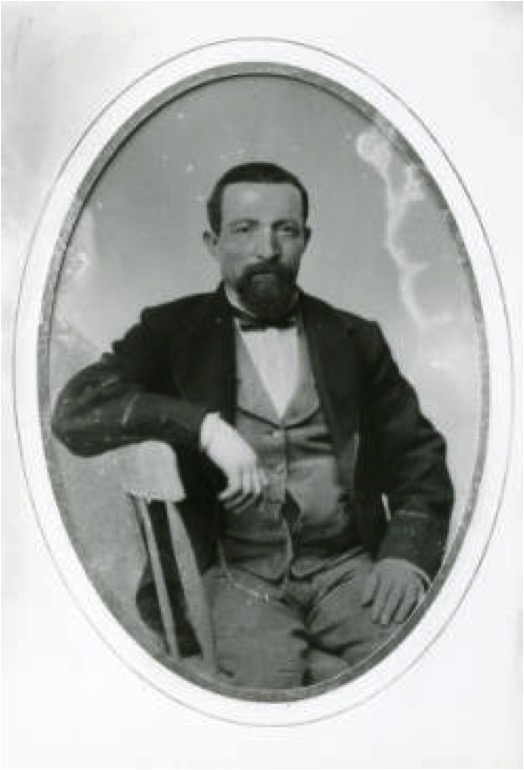 Morris Mensor. SOHS #363. Morris Mensor. SOHS #363. |
In 1863, the building was leased to Max Muller (see Stop #13). In 1870 Gustav Karewski (see Stop #12) leased the building for five years at an annual rent of $300 in gold coin. That same year he also purchased land immediately behind the Brunner Brothers store and erected a stone warehouse, the first site of Karewski’s Agricultural Implements Barn—an investment sufficiently successful for Karewski to add a second story three years later. Karewski retained ownership of his warehouse but relinquished the store when his lease expired.
In 1876, Goldsmith leased the store to Morris Mensor. Mensor, who was well known as one of Jacksonville’s enterprising businessmen, had previously operated in several locations around town. He immediately stocked the building with a large supply of general merchandise in preparation for the opening of his “New York Store.”
|
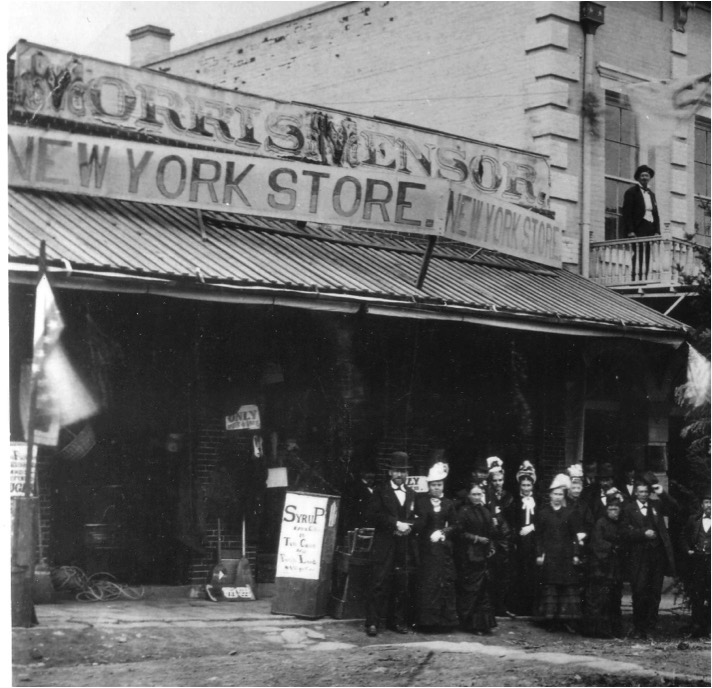 Morris Mensor’s New York Store; SOHS #21350. Morris Mensor’s New York Store; SOHS #21350.
With the coming of the railroad, Medford was beginning to eclipse Jacksonville as the commercial center of the Rogue Valley. The fire of 1888 did not help. Originating in David Linn’s planning mill at the corner of California and Oregon streets, it took out the “frame rookeries on the south side of California Street” that had become Jacksonville’s “Chinatown” along with the second story of Karewski’s brick and stone warehouse. The Brunner building was apparently untouched, protected by the 2-story Orth block.
For the next few years, the Brunner building stood vacant but by 1898 it was being used for flour and feed storage.
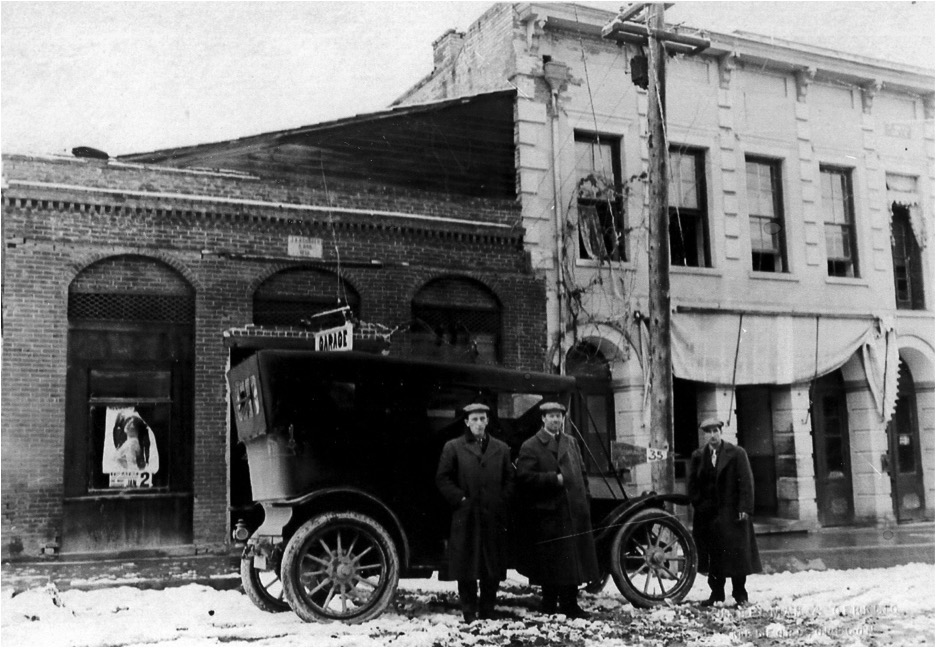 Brunner Building as Garage; SOHS. Brunner Building as Garage; SOHS.
As “motoring” became popular, the building was turned into a garage. To accommodate automobiles, the central front bay was widened and fitted with a garage door in 1914. The side bays were filled in and converted to windows.
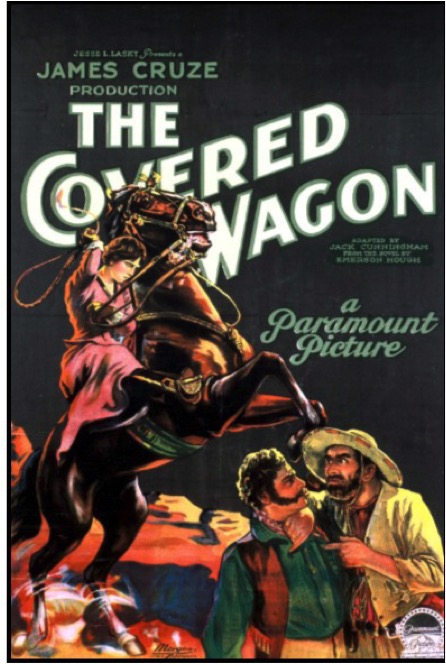 Paramount Pictures Promotional Poster Paramount Pictures Promotional Poster |
In 1923, when Paramount Pictures released its popular and critically acclaimed silent movie, “The Covered Wagon,” it intensified local interest in “old pioneer days.” The film depicted the settlement of Oregon and was the industry’s first historical “Epic Big Screen Western.” Jacksonville residents determined the town needed a museum. Inspired by the film and the upcoming Jacksonville reunion of the Pioneer Society of Southern Oregon, Alice Applegate Sargent purchased the Brunner building with the goal of creating “a repository for pioneer relics” and donated it to the Jane McCully Cabin No. 1 of the Native Daughters of Oregon. Jacksonville’s new museum opened briefly for the society’s annual meeting in October 1924, then had its formal opening February 27, 1925. Open on Tuesdays and Fridays, local newspapers reported that it attracted so many visitors that Mrs. Sargent and her assistant were kept very busy!
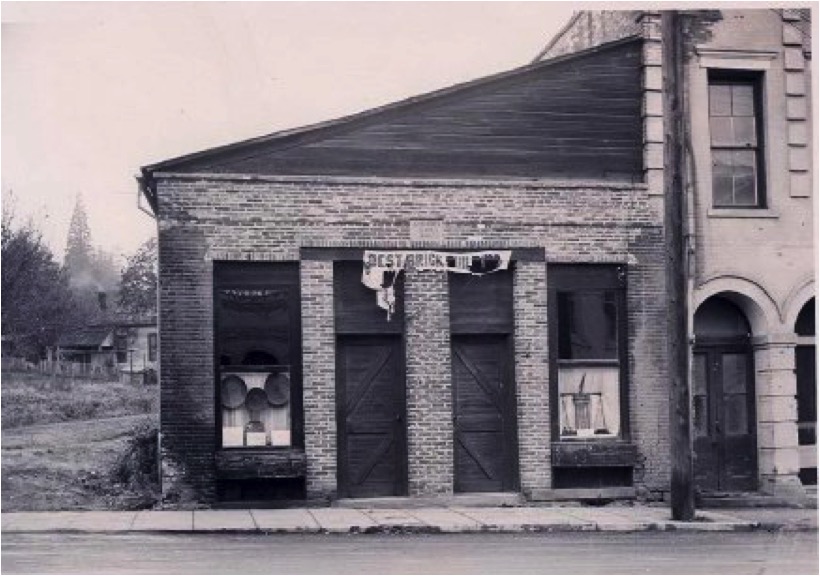 Brunner Building as Musuem; SOHS Brunner Building as Musuem; SOHS
Around the same time, Jackson County was seeking to establish a cooperative public library arrangement throughout the county. Jacksonville, with a population of only 489 people, was one of the first to respond. A “suitable” room of the Brunner building was devoted to the library and on two afternoons and one evening each week, Mrs. H. K. Hanna, the first librarian and also a “Native Daughter,” supervised the circulation of 290 books.
The space for both museum and library became much too cramped.
By the late 1930s, the City approved a museum in the U.S. Hotel. Both spaces operated simultaneously for a number of years until the U.S. Hotel became the “formal” museum and the Native Daughters turned the Brunner space over to the library.
In 1956, Mrs. Hanna, on behalf of the Native Daughters, officially presented the Brunner building to the town as its public library. It served as such until the 2000 County-wide bond measure funded construction of the current Jacksonville library on West C Street.
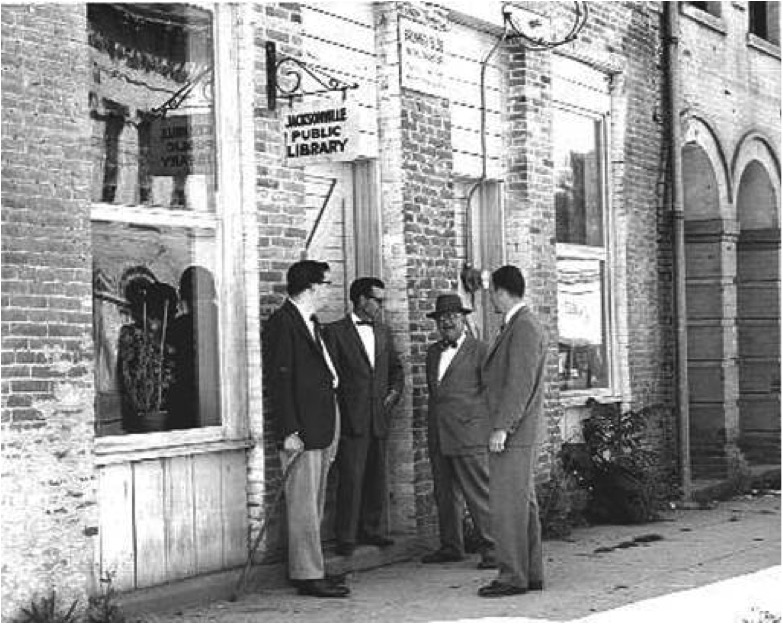 Jacksonville Public Library, 1925-2002. SOHS Jacksonville Public Library, 1925-2002. SOHS
The Brunner building continues to serve the community. Today it houses the Old Library Collectibles and Thrift Shop, the profits from which go towards funding the Jacksonville Community Center.
Sources Cited
Gail E.H. Evans, Jacksonville Historical Survey, 1980.
Historic American Buildings Survey, 1975.
A.G. Walling, History of Southern Oregon Comprising Jackson, Josephine, Douglas, Curry and Coos Counties, 1984.
Robert E. Levinson, The Jews of Jacksonville, Oregon. University of Oregon M.A. thesis, 1962.
Jackson County Deeds
1852 Jackson County Census.
Table Rock Sentinel, August 1, 1857.
|